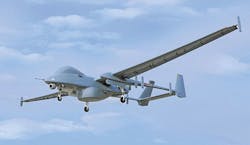Wrong again: UAV market heading nowhere but up over the next decade
I was under the impression that UAVs -- popularly called drones -- were starting to represent a market that was leveling off after years of steep growth. Gazing out over the military UAV landscape, it seemed to me that about everyone in the U.S military who wanted a UAV already had one.
Instead, it was starting to look like the military UAV market was showing signs of switching from new systems to maintenance and upgrades of existing platforms, as well as to continued growth in UAV payloads for sensors, signals intelligence (SIGINT), electronic warfare (EW), and many other applications.
Boy was I wrong ... at least according to analysts at the Teal Group, a market research firm in Fairfax, Va., who making as living closely following the UAV market.
Related: Worldwide UAV and drone spending to more than triple over next decade, say Teal analysts
Teal's World Unmanned Aerial Vehicle Systems, Market Profile and Forecast 2015, released earlier this month, says worldwide spending on unmanned aerial vehicles (UAVs) will more than triple over the next decade, growing from $4 billion this year to $14 billion by 2024.
So much for a flattening market. Military UAV spending will make up 72 percent of the UAV market over the next decade, followed by 23 percent consumer, and 5 percent civil, analysts say. Military UAV research alone is expected to be a $30 billion market over the next year, Teal analysts say.
In my defense, I never thought the UAV payload market was cooling off, and Teal analysts confirm this in their annual UAV market forecast. Spending for UAV payloads for surveillance and reconnaissance should double over the next decade, increasing from $3.1 billion this year to $6.4 billion in 2024, analysts say.
Demand for UAV payloads should remain in growth mode for electro-optic/infrared sensors (EO/IR), synthetic aperture radars (SAR), SIGINT, EW, and command, control, communications, and intelligence (C4I) systems, while new-technology UAV payloads with RF sensors also should see healthy growth over the next decade, analysts say.
Related: Electro-optical sensor payloads for small UAVs
I'm trying to figure out what misled me so. I think it had a lot to do with what I saw at recent annual trade shows of the Association for Unmanned Vehicle Systems International (AUVSI). The last show or two seemed to be very light on military UAVs, with growing emphasis on commercial, civil, and even hobby unmanned aircraft, as well as on UAV payloads.
Previous years saw a lot of Global Hawk- and Predator-type of heavy-iron UAVs on the AUVSI show floor, while the most recent show in Atlanta was heavy on quad-copters and other small systems that have been giving airports and security personnel such fits lately.
The AUVSI show, by the way, is changing it name to XPONENTIAL, an AUVSI Experience, for the 2016 show next May in New Orleans. When I first heard of it, I thought changing the well-known name AUVSI to XPONENTIAL was kind of a dumb idea. Why throw away such well-known branding?
Well, as wrong as I was about the UAV market, I may well be wrong about the AUVSI name change to XPONENTIAL. I think there are people in this market who know a lot more about these things than I do.

